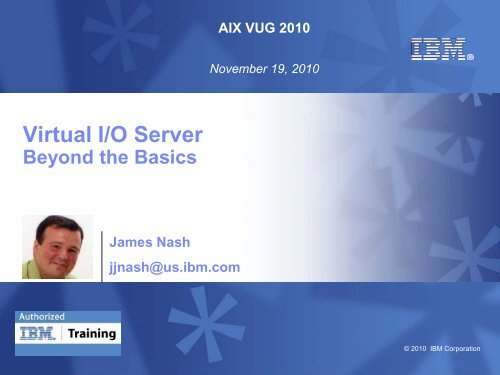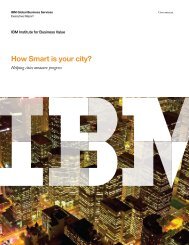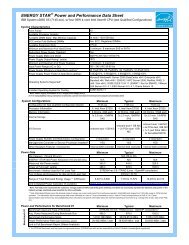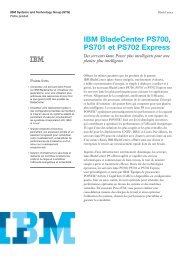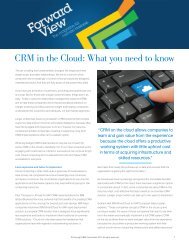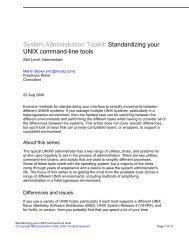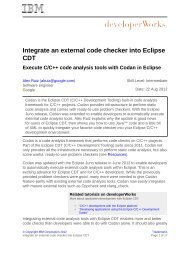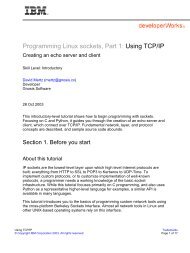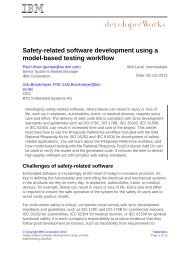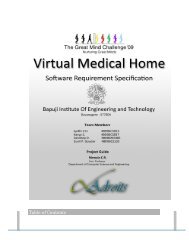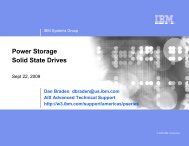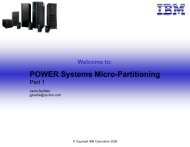Virtual I/O Server - IBM
Virtual I/O Server - IBM
Virtual I/O Server - IBM
Create successful ePaper yourself
Turn your PDF publications into a flip-book with our unique Google optimized e-Paper software.
<strong>Virtual</strong> I/O <strong>Server</strong><br />
Beyond the Basics<br />
James Nash<br />
jjnash@us.ibm.com<br />
AIX VUG 2010<br />
November 19, 2010<br />
© 2010 <strong>IBM</strong> Corporation
2<br />
AIX VUG 2010<br />
Trademarks<br />
The following are trademarks of the International Business Machines Corporation in the United States, other countries, or both.<br />
Not all common law marks used by <strong>IBM</strong> are listed on this page. Failure of a mark to appear does not mean that <strong>IBM</strong> does not use the mark nor does it mean that the product is not<br />
actively marketed or is not significant within its relevant market.<br />
Those trademarks followed by ® are registered trademarks of <strong>IBM</strong> in the United States; all others are trademarks or common law marks of <strong>IBM</strong> in the United States.<br />
For a complete list of <strong>IBM</strong> Trademarks, see www.ibm.com/legal/copytrade.shtml:<br />
*, AS/400®, e business(logo)®, DBE, ESCO, e<strong>Server</strong>, FICON, <strong>IBM</strong>®, <strong>IBM</strong> (logo)®, iSeries®, MVS, OS/390®, pSeries®, RS/6000®, S/30, VM/ESA®, VSE/ESA,<br />
WebSphere®, xSeries®, z/OS®, zSeries®, z/VM®, System i, System i5, System p, System p5, System x, System z, System z9®, BladeCenter®<br />
The following are trademarks or registered trademarks of other companies.<br />
Adobe, the Adobe logo, PostScript, and the PostScript logo are either registered trademarks or trademarks of Adobe Systems Incorporated in the United States, and/or other countries.<br />
Cell Broadband Engine is a trademark of Sony Computer Entertainment, Inc. in the United States, other countries, or both and is used under license therefrom.<br />
Java and all Java-based trademarks are trademarks of Sun Microsystems, Inc. in the United States, other countries, or both.<br />
Microsoft, Windows, Windows NT, and the Windows logo are trademarks of Microsoft Corporation in the United States, other countries, or both.<br />
Intel, Intel logo, Intel Inside, Intel Inside logo, Intel Centrino, Intel Centrino logo, Celeron, Intel Xeon, Intel SpeedStep, Itanium, and Pentium are trademarks or registered trademarks of Intel<br />
Corporation or its subsidiaries in the United States and other countries.<br />
UNIX is a registered trademark of The Open Group in the United States and other countries.<br />
Linux is a registered trademark of Linus Torvalds in the United States, other countries, or both.<br />
ITIL is a registered trademark, and a registered community trademark of the Office of Government Commerce, and is registered in the U.S. Patent and Trademark Office.<br />
IT Infrastructure Library is a registered trademark of the Central Computer and Telecommunications Agency, which is now part of the Office of Government Commerce.<br />
* All other products may be trademarks or registered trademarks of their respective companies.<br />
Notes:<br />
Performance is in Internal Throughput Rate (ITR) ratio based on measurements and projections using standard <strong>IBM</strong> benchmarks in a controlled environment. The actual throughput that any user will<br />
experience will vary depending upon considerations such as the amount of multiprogramming in the user's job stream, the I/O configuration, the storage configuration, and the workload processed.<br />
Therefore, no assurance can be given that an individual user will achieve throughput improvements equivalent to the performance ratios stated here.<br />
<strong>IBM</strong> hardware products are manufactured from new parts, or new and serviceable used parts. Regardless, our warranty terms apply.<br />
All customer examples cited or described in this presentation are presented as illustrations of the manner in which some customers have used <strong>IBM</strong> products and the results they may have achieved. Actual<br />
environmental costs and performance characteristics will vary depending on individual customer configurations and conditions.<br />
This publication was produced in the United States. <strong>IBM</strong> may not offer the products, services or features discussed in this document in other countries, and the information may be subject to change without<br />
notice. Consult your local <strong>IBM</strong> business contact for information on the product or services available in your area.<br />
All statements regarding <strong>IBM</strong>'s future direction and intent are subject to change or withdrawal without notice, and represent goals and objectives only.<br />
Information about non-<strong>IBM</strong> products is obtained from the manufacturers of those products or their published announcements. <strong>IBM</strong> has not tested those products and cannot confirm the performance,<br />
compatibility, or any other claims related to non-<strong>IBM</strong> products. Questions on the capabilities of non-<strong>IBM</strong> products should be addressed to the suppliers of those products.<br />
Prices subject to change without notice. Contact your <strong>IBM</strong> representative or Business Partner for the most current pricing in your geography.<br />
© 2010 <strong>IBM</strong> Corporation
3<br />
AIX VUG 2010<br />
© 2010 <strong>IBM</strong> Corporation
4<br />
New (and almost new) Features<br />
<strong>Virtual</strong> I/O <strong>Server</strong> Topics<br />
• Networking<br />
AIX VUG 2010<br />
Agenda<br />
─ Shared Ethernet Adapters<br />
─ Integrated <strong>Virtual</strong> Ethernet<br />
─ MAC Addresses<br />
• <strong>Virtual</strong> Storage<br />
─ N_Port Id <strong>Virtual</strong>ization<br />
• Live Partition Mobility<br />
─ Boot from SAN?<br />
• Infrequently used alternatives<br />
─ <strong>Virtual</strong> Media Library<br />
─ backupios vs viosbr<br />
─ Dynamic VLAN<br />
─ Quality of Service<br />
─ WWN Management<br />
© 2010 <strong>IBM</strong> Corporation
Enhancements<br />
v2.1.2 – Oct 2009<br />
v2.1.3 – Apr 2010<br />
v2.2.0 – Oct 2010<br />
© 2008 <strong>IBM</strong> Corporation<br />
© 2010 <strong>IBM</strong> Corporation
AIX VUG 2010<br />
Enhancements added with v2.1.2 (Oct 2009)<br />
� Live Partition Mobility (LPM)<br />
– Preservation of <strong>Virtual</strong> Target Device names or ability to change names<br />
– IPSEC Encryption of MSP to MSP traffic<br />
– Network Interface selection for MSP to MSP communications<br />
– Ability to create non-symmetric VIO server configurations<br />
– Support for shared persistent reservations (PR_shared)<br />
� N_Port Id <strong>Virtual</strong>ization (NPIV)<br />
– Dynamic remapping of vFC adapter to a physical port<br />
– Concurrent microcode updates for NPIV adapters/ports<br />
– Support for additional Blade Fibre Channel adapters<br />
• FC 8240<br />
• FC 8242<br />
• FC8271<br />
� New commands chkdev, postprocesssvc, and viosbr<br />
� Official support for Solid State Drives in a virtual environment<br />
� Latest version of SDDPCM<br />
6<br />
© 2010 <strong>IBM</strong> Corporation
7<br />
AIX VUG 2010<br />
Enhancements to Live Partition Mobility (v2.1.2)<br />
� Preservation of <strong>Virtual</strong> Target Device names<br />
– If the VTD had a user defined name on the source VIOS that name will now be<br />
recreated on the destination VIOS.<br />
� Ability to change virtual target device names during a migration<br />
operation<br />
$ lsdev -dev vtscsi0 -attr<br />
attribute value description user_settable<br />
LogicalUnitAddr 0x8100000000000000 Logical Unit Address False<br />
aix_tdev hdisk7 Target Device Name False<br />
client_reserve no Client Reserve True<br />
mig_name N/A True<br />
$ chdev -dev vtscsi0 -attr mig_name=test<br />
vtscsi0 changed<br />
$ lsdev -dev vtscsi0 -attr<br />
attribute value description user_settable<br />
LogicalUnitAddr 0x8100000000000000 Logical Unit Address False<br />
aix_tdev hdisk7 Target Device Name False<br />
client_reserve no Client Reserve True<br />
mig_name test N/A True<br />
© 2010 <strong>IBM</strong> Corporation
8<br />
AIX VUG 2010<br />
Enhancements to Live Partition Mobility (v2.1.2)<br />
� Ability to encrypt traffic between the source and destination<br />
Mover Service Partition (MSP)<br />
– A command line interface (CLI) has been added to the VIOS<br />
to allow the creation of an IPSEC tunneled connection<br />
between the mover service partitions (MSPs) that are<br />
responsible for moving a client’s data during a live partition<br />
mobility event.<br />
– To enable encryption on the VIOS, the clic.rte package must<br />
be installed.<br />
© 2010 <strong>IBM</strong> Corporation
9<br />
AIX VUG 2010<br />
Enhancements to Live Partition Mobility (v2.1.2)<br />
� Ability to select network interface to be used for MSP to<br />
MSP communications<br />
– If multiple network interfaces are available between a pair of<br />
Mover Service Partitions, it is now possible through the HMC<br />
command line to select which IP address the mover will use<br />
to transport client partition data during a live partition mobility<br />
event.<br />
� See HMC man pages for migrlpar for more details<br />
hscroot@sahmc:~> migrlpar -o m -m p6_570 -t p7_770 --id 5<br />
--ip 10.56.145.201 -u hscroot –i<br />
"source_msp_ipaddr=10.0.0.1,dest_msp_ipaddr=10.0.0.4"<br />
© 2010 <strong>IBM</strong> Corporation
AIX VUG 2010<br />
Enhancements to Live Partition Mobility (v2.1.2)<br />
� The ability to create non-symmetric VIO server configurations<br />
$ migrlpar with –mpio flag<br />
10<br />
When validating or migrating a partition, use this<br />
option to specify whether the HMC is required to<br />
maintain an equivalent multipath I/O (MPIO)<br />
configuration of the partition's virtual SCSI and<br />
virtual fibre channel adapters on the destination<br />
managed system. Valid values are 1 if the HMC is<br />
required to maintain an equivalent MPIO<br />
configuration, or 2 if the HMC is not required to<br />
maintain an equivalent MPIO configuration, but should<br />
do so if possible. If this option is not specified,<br />
then this option defaults to the value 1.<br />
© 2010 <strong>IBM</strong> Corporation
AIX VUG 2010<br />
New VIO <strong>Server</strong> Commands (v2.1.2)<br />
$ chkdev - command determines whether a device can be<br />
used in physical to virtual transitions in the <strong>Virtual</strong> I/O <strong>Server</strong><br />
$ chkdev -dev hdisk4 -verbose<br />
NAME: hdisk4<br />
IDENTIFIER: 37213600A0B8000170BC10000E3544B953DB7081722-<br />
60003<strong>IBM</strong>fcp<br />
PHYS2VIRT_CAPABLE: NA<br />
VIRT2NPIV_CAPABLE: YES<br />
VIRT2PHYS_CAPABLE: YES<br />
PVID: 0001ad724a4674550000000000000000<br />
UDID: 37213600A0B8000170BC10000E3544B953DB7081722-<br />
60003<strong>IBM</strong>fcp<br />
IEEE:<br />
VTD: fs6_rootvg<br />
11<br />
$ chkdev -dev hdisk3<br />
NAME: hdisk2<br />
IDENTIFIER: 291135000C5000A85C5470AST373455SS03<strong>IBM</strong>sas<br />
PHYS2VIRT_CAPABLE: YES<br />
VIRT2NPIV_CAPABLE: NA<br />
VIRT2PHYS_CAPABLE: NA<br />
© 2010 <strong>IBM</strong> Corporation
AIX VUG 2010<br />
New VIO <strong>Server</strong> Commands (v2.1.2)<br />
$ viosbr -backup file backup -frequency daily numfiles 5<br />
Creates a backup file once a day, prefixed with “backup”<br />
in /home/padmin/cfgbackups<br />
– backup.01.tar.gz<br />
– backup.02.tar.gz<br />
– backup.03.tar.gz<br />
– backup.04.tar.gz<br />
– backup.05.tar.gz<br />
$ viosbr -restore file /home/padmin/cfgbackups/backup.03.tar.gz<br />
12<br />
© 2010 <strong>IBM</strong> Corporation
Enhancements<br />
v2.1.2 – Oct 2009<br />
v2.1.3 – Apr 2010<br />
v2.2.0 – Oct 2010<br />
© 2008 <strong>IBM</strong> Corporation<br />
© 2010 <strong>IBM</strong> Corporation
AIX VUG 2010<br />
NPIV support for FCoE (v2.1.3)<br />
� FCoE adapters now support NPIV devices<br />
– QLogic FCoCEE NPIV Blade Expansion Adapter (FC 8275)<br />
– QLogic FCoCEE NPIV adapter (FC 5708)<br />
� Provides new NPIV support for other adapters in addition<br />
to the original FC 5735, 8Gb NPIV cards<br />
14<br />
© 2010 <strong>IBM</strong> Corporation
15<br />
AIX VUG 2010<br />
VIO Support of AIX Runtime Expert (v2.1.3)<br />
� Five new commands added to the padmin shell<br />
– artexget Creates a new profile<br />
– artexset Applies a profile to a system<br />
– artexdiff Compares a profile against exiting settings<br />
– artexlist Finds profiles in a given path<br />
– artexmerge Combines multiple profiles into a single profile<br />
© 2010 <strong>IBM</strong> Corporation
16<br />
AIX VUG 2010<br />
New Flag for backupios command (v2.1.3)<br />
� New –nomedialib flag added to exclude contents of<br />
the virtual media repository<br />
� Ability to create smaller backups of the VIO server<br />
when the media library is being used<br />
© 2010 <strong>IBM</strong> Corporation
17<br />
AIX VUG 2010<br />
PowerVM Enterprise Edition Trial (4/21/2010)<br />
� Try advanced features of PowerVM Enterprise<br />
Edition on a 60-day trial basis before you buy<br />
─Verify LPM works in your environment<br />
─Show the benefit of using AMS<br />
� System must already have PowerVM Standard<br />
Edition with current SWMA<br />
� Can be ordered with P/RPQ 8R7100<br />
© 2010 <strong>IBM</strong> Corporation
Enhancements<br />
v2.1.2 – Oct 2009<br />
v2.1.3 – Apr 2010<br />
v2.2.0 – Oct 2010<br />
© 2008 <strong>IBM</strong> Corporation<br />
© 2010 <strong>IBM</strong> Corporation
19<br />
What sudo?<br />
AIX VUG 2010<br />
Role Based Access Control (v2.2.0.0)<br />
© 2010 <strong>IBM</strong> Corporation
20<br />
AIX VUG 2010<br />
Enhanced <strong>Virtual</strong> Networking (v2.2.0.11-FP24 SP01)<br />
© 2010 <strong>IBM</strong> Corporation
21<br />
AIX VUG 2010<br />
Linked Clones (v2.2.0.11-FP24 SP01)<br />
Announce Oct 7, 2010 - GA Dec. 10<br />
� Partitions that share large amounts of common code<br />
will have the ability to share this code.<br />
� Partition will still need space to store unique files.<br />
� Advantages<br />
─Less storage needed for partitions<br />
─Ability to easily manage files that should remain the<br />
same on a set of partitions<br />
─Could be used to help create a template for groups<br />
of partitions<br />
© 2010 <strong>IBM</strong> Corporation
22<br />
AIX VUG 2010<br />
Thin Provisioning (v2.2.0.11-FP24 SP01)<br />
Announce Oct 7, 2010 - GA Dec. 10<br />
� Additional storage is provided as workloads and<br />
demands increase.<br />
� Storage can also be released as workloads contract.<br />
� Advantages<br />
─Leave room to grow<br />
─Method to over-commit storage<br />
─Ease workload of storage administrators<br />
© 2010 <strong>IBM</strong> Corporation
AIX VUG 2010<br />
Partition Suspend/Resume (v2.2.0.11-FP24 SP01)<br />
Announce Oct 7, 2010 - GA Dec. 10<br />
23<br />
� Write the contents of memory out to state file(s).<br />
� Resume workload exactly where it was stopped<br />
� Ability to suspend workload on one system and<br />
resume on a different system<br />
� Advantages<br />
─Resource balancing<br />
─System maintenance<br />
─Debug by suspending and taking copy of workload<br />
to another system for anaylsis<br />
© 2010 <strong>IBM</strong> Corporation
Additional Details<br />
24<br />
AIX VUG 2010<br />
POWER5 / POWER6 / POWER7 Supported<br />
Shared storage pools<br />
Thin provisioning<br />
POWER7 Supported only<br />
Partition Suspend / Resume<br />
© 2010 <strong>IBM</strong> Corporation
AIX VUG 2010<br />
VIO New Feature Dates<br />
VIO RBAC In VIO 2.2 build available on 9/17<br />
Partition Suspend/Resume Announce 10/7, GA 12/10<br />
Linked Clones Announce 10/7, GA 12/10<br />
Thin Provisioning Announce 10/7, GA 12/10<br />
Additional Features to be added in 2011<br />
25<br />
© 2010 <strong>IBM</strong> Corporation
Enhancements<br />
v2.1.2 – Oct 2009<br />
v2.1.3 – Apr 2010<br />
v2.2.0 – Oct 2010 Questions?<br />
© 2008 <strong>IBM</strong> Corporation<br />
© 2010 <strong>IBM</strong> Corporation
27<br />
AIX VUG 2010<br />
<strong>Virtual</strong> Networking - Overview<br />
─ Shared Ethernet Adapters Options<br />
─ SEA Failover<br />
─ Network Interface Backup<br />
─ Link Aggregation<br />
─ Integrated <strong>Virtual</strong> Ethernet Changes<br />
─ Advanced <strong>Virtual</strong> Ethernet Adapters<br />
─ Dynamic VLAN<br />
─ User-defined MAC Address<br />
─ Quality of Service<br />
© 2010 <strong>IBM</strong> Corporation
AIX VUG 2010<br />
<strong>Virtual</strong> Networking – Shared Ethernet Adapters<br />
28<br />
© 2010 <strong>IBM</strong> Corporation
AIX VUG 2010<br />
<strong>Virtual</strong> Networking – Integrated <strong>Virtual</strong> Ethernet<br />
29<br />
FC 5636, 2 x 1Gb<br />
POWER6 Options<br />
Up to 16 Logical Ports per<br />
Port Group<br />
Up to 2 Port Groups per HEA<br />
FC 5637, 4 x 1Gb FC 5639, 2 x 10Gb<br />
© 2010 <strong>IBM</strong> Corporation
� POWER7 770 (9117-MMB)<br />
AIX VUG 2010<br />
IVE Options with POWER7<br />
– FC 1803 Integrated, 4-port- 1Gb <strong>Virtual</strong> Ethernet, I/O ports<br />
– FC 1804 Integrated, 4-port (2x1Gb and 2x10Gb SFP+ Optical ports)<br />
– FC 1813 Integrated, 4-port (2x1Gb and 2x10Gb SFP+ Copper twinax<br />
ports)<br />
• Each of these cards contains 4 port groups because it combines two P5IOC2<br />
chips<br />
• 4 port groups allows for up to 64 logical ports per controller (assuming the<br />
MCS value for each port group is set to 1)<br />
� POWER 750 (8233-E8B)<br />
<strong>IBM</strong><br />
– FC 5613 Integrated, Dual-port- 10Gb <strong>Virtual</strong> Ethernet Daughter Card<br />
– FC 5624 4-port 1Gb Integrated <strong>Virtual</strong> Ethernet Daughter Card<br />
• Same rules that apply to POWER6 systems<br />
• 2 port groups with up to a total of 32 logical ports per controller (also<br />
assuming the MCS value is set to 1)<br />
© 2010 <strong>IBM</strong> Corporation
AIX VUG 2010<br />
<strong>Virtual</strong> Networking – Integrated <strong>Virtual</strong> Ethernet<br />
31<br />
– FC 1803 Integrated, 4-port – 1Gb <strong>Virtual</strong> Ethernet, I/O ports<br />
– FC 1804 Integrated, 4-port (2 x 1Gb and 2 x 10Gb SFP+ Optical ports)<br />
– FC 1813 Integrated, 4-port (2 x 1Gb and 2 x 10Gb SFP+ Copper ports)<br />
– FC 1824 Integrated, 4-port – 1Gb <strong>Virtual</strong> Ethernet, I/O ports<br />
– FC 1825 Integrated, 2-port – 2 x 10Gb (Fiber)<br />
– FC 1826 Integrated, 4-port – 2 x 10Gb (Copper)<br />
– FC 1832 Integrated, 4-port - 1Gb <strong>Virtual</strong> Ethernet, I/O ports<br />
– FC 1833 Integrated, 2-port – 2 x 10Gb (Fiber)<br />
– FC 1837 Integrated, 4-port – 2 x 10Gb (Copper)<br />
– FC 5613 Integrated, 2-port – 10Gb (SR Fiber)<br />
– FC 5623 Integrated, 2-port – 2 x 1Gb<br />
– FC 1826 Integrated, 4-port – 2 x 1Gb<br />
© 2010 <strong>IBM</strong> Corporation
AIX VUG 2010<br />
<strong>Virtual</strong> Networking – Integrated <strong>Virtual</strong> Ethernet<br />
32<br />
Machine FC FC FC Note<br />
710 1832 1833 1837 2U<br />
720 1824 1825 1826 4U<br />
730 1832 1833 1837 2U<br />
740 1824 1825 1826 4U<br />
750 5613 5623 5624 2 Port Groups<br />
755 5613 5624 2 Port Groups<br />
770 1803 1804 1813 4 Port Groups<br />
780 1803 1804 1813 4 Port Groups<br />
795 N/A<br />
© 2010 <strong>IBM</strong> Corporation
33<br />
AIX VUG 2010<br />
<strong>Virtual</strong> Networking – Dynamic VLANs<br />
© 2010 <strong>IBM</strong> Corporation
34<br />
AIX VUG 2010<br />
Other Dynamic Options<br />
© 2010 <strong>IBM</strong> Corporation
35<br />
AIX VUG 2010<br />
<strong>Virtual</strong> Networking – Specify a MAC Address<br />
© 2010 <strong>IBM</strong> Corporation
36<br />
AIX VUG 2010<br />
<strong>Virtual</strong> Networking – Specify a MAC Address<br />
octet: 1st 2nd 3rd 4th 5th 6th<br />
Most Least<br />
1 2 3 4 5 6 7 8 9 0 A B<br />
Significant Significant<br />
0 0 0 1 0 0 1 0<br />
bit 8 bit 7 bit 6 bit 5 bit 4 bit 3 bit 2 bit 1<br />
0: globally unique (OUI enforced)<br />
1: locally administered<br />
© 2010 <strong>IBM</strong> Corporation
37<br />
AIX VUG 2010<br />
<strong>Virtual</strong> Networking – Specify a MAC Address<br />
© 2010 <strong>IBM</strong> Corporation
38<br />
AIX VUG 2010<br />
<strong>Virtual</strong> Networking – Quality of Service<br />
© 2010 <strong>IBM</strong> Corporation
Double Check Yourself<br />
39<br />
AIX VUG 2010<br />
You can select one of the following values<br />
for the priority level:<br />
0 - best effort; lowest priority<br />
1 - background<br />
2 - spare<br />
3 - excellent effort<br />
4 - controlled load<br />
5 - video (less than 100 ms latency and jitter)<br />
6 - voice (less than 10 ms latency and jitter)<br />
7 - network control; highest priority<br />
© 2010 <strong>IBM</strong> Corporation
40<br />
AIX VUG 2010<br />
<strong>Virtual</strong> Storage - Overview<br />
─ The vSCSI Conundrum<br />
─ <strong>Virtual</strong> Storage with Live Partition Mobility<br />
─ Hub-and-spoke<br />
─ N_Port Id <strong>Virtual</strong>ization<br />
─ WWN Management<br />
© 2010 <strong>IBM</strong> Corporation
41<br />
VIO <strong>Server</strong><br />
AIX VUG 2010<br />
<strong>Virtual</strong> Storage - vSCSI<br />
Client<br />
LPAR<br />
Client<br />
LPAR<br />
Client<br />
LPAR<br />
POWER Hypervisor (PHYP)<br />
VIO<br />
<strong>Server</strong> 1<br />
Client LPAR<br />
vscsi0 vscsi1<br />
vhost0 vhost0 VIO<br />
fcs0 fcs1<br />
fcs0<br />
fcs1<br />
SAN<br />
Switch #1<br />
SAN Storage<br />
SAN<br />
Switch #2<br />
<strong>Server</strong> 2<br />
© 2010 <strong>IBM</strong> Corporation
Where did that disk go?<br />
42<br />
VIO <strong>Server</strong> Client<br />
LPAR<br />
At one point the disks had to<br />
be configured with a<br />
reserve_policy = no_reserve<br />
PR_shared supported at<br />
VIO v2.1.2<br />
Client<br />
LPAR<br />
AIX VUG 2010<br />
Client<br />
LPAR<br />
Keep a spreadsheet<br />
Check all the VIO servers<br />
Consider NPIV<br />
VIO <strong>Server</strong> Client<br />
LPAR<br />
Client<br />
LPAR<br />
Client<br />
LPAR<br />
© 2010 <strong>IBM</strong> Corporation
AIX VUG 2010<br />
Consider a Hub and Spoke Design<br />
43<br />
VIO <strong>Server</strong><br />
VIO <strong>Server</strong><br />
Client<br />
LPAR<br />
Client<br />
LPAR<br />
Client<br />
LPAR<br />
Client<br />
LPAR<br />
Client<br />
LPAR<br />
Client<br />
LPAR<br />
VIO <strong>Server</strong><br />
VIO <strong>Server</strong><br />
VIO <strong>Server</strong><br />
Client<br />
LPAR<br />
Client<br />
LPAR<br />
Client<br />
LPAR<br />
Client<br />
LPAR<br />
Client<br />
LPAR<br />
Client<br />
LPAR<br />
© 2010 <strong>IBM</strong> Corporation
44<br />
AIX VUG 2010<br />
NPIV - <strong>Virtual</strong> FC <strong>Server</strong>/Client Overview<br />
Physical 8Gb<br />
NPIV Adapter<br />
<strong>Virtual</strong> FC<br />
<strong>Server</strong> Adapter<br />
<strong>Virtual</strong> FC<br />
Client Adapter<br />
VIO <strong>Server</strong><br />
Client<br />
LPAR<br />
Client<br />
LPAR<br />
POWER Hypervisor (PHYP)<br />
Client<br />
LPAR<br />
© 2010 <strong>IBM</strong> Corporation
45<br />
AIX VUG 2010<br />
<strong>Virtual</strong> Storage – NPIV Configuration<br />
hscroot@hmc:~> lssyscfg –r prof –m FieldSystem1 \<br />
–F lpar_name,virtual_fc_adapters<br />
fs5,"""20/client/1/fs6vio2/20/c050760061590000,c050760061590001/0"",<br />
“"21/client/2/fs6vio3/21/c050760061590002,c050760061590003/0""“<br />
fs6,"""22/client/1/fs6vio2/22/c050760061590004,c050760061590005/0"",<br />
""23/client/2/fs6vio3/23/c050760061590006,c050760061590007/0""“<br />
fsios71,none<br />
fsios61,none<br />
fs6vio3,"21/server/7/fs5/21//0,23/server/6/fs6/23//0“<br />
fs6vio2,"20/server/7/fs5/20//0,22/server/6/fs6/22//0"<br />
© 2010 <strong>IBM</strong> Corporation
46<br />
AIX VUG 2010<br />
<strong>Virtual</strong> Storage – WWN Management<br />
# lscfg -vpl fcs0<br />
fcs0 U8203.E4A.06EB1C4-V8-C26-T1 <strong>Virtual</strong> Fibre Channel Client Adapter<br />
Network Address.............C05076006159000C<br />
ROS # Level fcstat and ID............ fcs0<br />
Device Specific.(Z0)........<br />
FIBRE CHANNEL STATISTICS REPORT: fcs0<br />
Device Specific.(Z1)........<br />
Device Specific.(Z2)........<br />
Device<br />
Device<br />
Specific.(Z3)........<br />
Type: FC Adapter (adapter/vdevice/<strong>IBM</strong>,vfc-client)<br />
Device<br />
Serial<br />
Specific.(Z4)........<br />
Number: UNKNOWN<br />
Device<br />
Option<br />
Specific.(Z5)........<br />
ROM Version: UNKNOWN<br />
Device<br />
Firmware<br />
Specific.(Z6)........<br />
Version: UNKNOWN<br />
Device World Specific.(Z7)........<br />
Wide Node Name: 0xC05076006159000D<br />
Device World Specific.(Z8)........C05076006159000C<br />
Wide Port Name: 0xC05076006159000D<br />
Device Specific.(Z9)........<br />
Hardware Location Code......U8203.E4A.06EB1C4-V8-C26-T1<br />
FC-4 TYPES:<br />
Supported: 0x0000010000000000000000000000000000000000000000000000000000000000<br />
PLATFORM SPECIFIC<br />
Active: 0x0000010000000000000000000000000000000000000000000000000000000000<br />
Name: vfc-client<br />
Class of Service: 3<br />
Node: vfc-client@3000001a<br />
Port Speed (supported): UNKNOWN<br />
Device Type: fcp<br />
Port Speed (running): 2 GBIT<br />
Physical Location: U8203.E4A.06EB1C4-V8-C26-T1<br />
Port FC ID: 0x6D071D<br />
Port Type: Fabric<br />
© 2010 <strong>IBM</strong> Corporation
47<br />
AIX VUG 2010<br />
<strong>Virtual</strong> Storage – WWN Management<br />
© 2010 <strong>IBM</strong> Corporation
AIX VUG 2010<br />
Activate the LPAR<br />
� Activate LPAR and select Boot<br />
Mode to be Open Firmware OK<br />
prompt<br />
© 2010 <strong>IBM</strong> Corporation
AIX VUG 2010<br />
This Page Intentionally Left Blank<br />
© 2010 <strong>IBM</strong> Corporation
AIX VUG 2010<br />
This Page Intentionally Left Blank<br />
© 2010 <strong>IBM</strong> Corporation
51<br />
AIX VUG 2010<br />
Manual Step?<br />
© 2010 <strong>IBM</strong> Corporation
Anywhere to Anywhere<br />
52<br />
VIO <strong>Server</strong><br />
VIO <strong>Server</strong><br />
Client<br />
LPAR<br />
Client<br />
LPAR<br />
Client<br />
LPAR<br />
Client<br />
LPAR<br />
Client<br />
LPAR<br />
Client<br />
LPAR<br />
AIX VUG 2010<br />
VIO <strong>Server</strong><br />
VIO <strong>Server</strong><br />
Client<br />
LPAR<br />
Client<br />
LPAR<br />
Client<br />
LPAR<br />
Client<br />
LPAR<br />
Client<br />
LPAR<br />
Client<br />
LPAR<br />
© 2010 <strong>IBM</strong> Corporation
53<br />
AIX VUG 2010<br />
<strong>Virtual</strong> Storage – NPIV simplify management?<br />
VIO Admin<br />
I. Fewer Devices on VIO <strong>Server</strong><br />
II. Minimize Risk for disk theft<br />
III. Less setup needed for LPM<br />
IV. Easier to replace failed FC<br />
adapter<br />
V. Could make DR easier<br />
VI. Advanced Multi-Path<br />
Options<br />
Single Admin?<br />
SAN Admin<br />
I. Many more WWNs to<br />
manage<br />
II. Creating Zoneset more<br />
complicated<br />
III. Once configured,<br />
fewer changes needed<br />
for LPM<br />
IV. Nothing needed when<br />
FC adapter is replaced<br />
© 2010 <strong>IBM</strong> Corporation
54<br />
AIX VUG 2010<br />
Live Partition Mobility - Overview<br />
─ Moving from POWER6 to POWER7<br />
─ Requirements<br />
─ In the Zone<br />
─ Port ID Binding<br />
─ Boot from SAN?<br />
─ Port Security<br />
─ Disaster Recovery<br />
© 2010 <strong>IBM</strong> Corporation
55<br />
AIX VUG 2010<br />
© 2010 <strong>IBM</strong> Corporation
Moving to POWER7<br />
� Set processor<br />
compatibility mode<br />
� P7 features are not<br />
available while running<br />
in P6 mode<br />
– Active Memory Expansion<br />
– <strong>Virtual</strong> Ethernet QoS<br />
� “Default” sets the<br />
current mode to the<br />
most fully featured<br />
mode supported by the<br />
operating environment.<br />
56<br />
AIX VUG 2010<br />
© 2010 <strong>IBM</strong> Corporation
57<br />
Physical 8Gb<br />
NPIV Adapter<br />
<strong>Virtual</strong> FC<br />
<strong>Server</strong> Adapter<br />
<strong>Virtual</strong> FC<br />
Client Adapter<br />
AIX VUG 2010<br />
Live Partition Mobility - Zoning<br />
VIO <strong>Server</strong><br />
Client<br />
LPAR<br />
Client<br />
LPAR<br />
POWER Hypervisor (PHYP)<br />
Client<br />
LPAR<br />
© 2010 <strong>IBM</strong> Corporation
58<br />
AIX VUG 2010<br />
Live Partition Mobility – Boot from SAN?<br />
� Do you want SDDPCM or PowerPath managing rootvg?<br />
– What does your storage vendor recommend<br />
– What are the requirements to update the MP software<br />
– What are the required steps for partition recovery<br />
� Can you split MP software by drive?<br />
SDD # excludesddcfg –l hdisk0 (queries older versions)<br />
HDLM # vi /usr/DynamicLinkManager/drv/dlmfdrv.unconf<br />
PowerPath # pprootdev on<br />
© 2010 <strong>IBM</strong> Corporation
59<br />
AIX VUG 2010<br />
Live Partition Mobility – Security<br />
© 2010 <strong>IBM</strong> Corporation
AIX VUG 2010<br />
Some advantages of <strong>Virtual</strong> Optical Media Library<br />
� With read-only virtual media the same virtual optical device can be presented to<br />
multiple client partitions simultaneously<br />
� You could easily boot from and install partitions remotely without having the need<br />
to swap out physical CD/DVDs or setup Network Installation Manager (NIM)<br />
server<br />
� Easier to boot a partition into maintenance mode to repair problems<br />
� Easier to maintain a complete library of all the software needed for the managed<br />
system. Various software packages as well as all the necessary software levels<br />
to support each partition<br />
� Client partitions could use blank file-backed virtual optical media for backup<br />
purposes (read/write devices)<br />
� These file-backed optical devices could then be backed up from on the VIO<br />
server to other types of media (tape, physical CD/DVD, TSM server, etc.)<br />
© 2010 <strong>IBM</strong> Corporation
AIX VUG 2010<br />
Add Media – within IVM<br />
© 2010 <strong>IBM</strong> Corporation
AIX VUG 2010<br />
<strong>Virtual</strong> Optical Media on HMC Managed Systems<br />
Managing the <strong>Virtual</strong> Media Repository<br />
VIO Command Description<br />
$ mkrep Create a <strong>Virtual</strong> media repository<br />
$ lsrep Display information on a <strong>Virtual</strong> Media Repository<br />
$ chrep Change characteristics of a <strong>Virtual</strong> Media Repository<br />
$ rmrep Remove a <strong>Virtual</strong> Media Repository<br />
Managing <strong>Virtual</strong> Optical Media<br />
VIO Command Description<br />
$ mkvopt Creates a new virtual optical disk in the <strong>Virtual</strong> Media Repository<br />
$ lsvopt Displays information about file backed virtual optical devices<br />
$ chvopt Change the characteristics of a virtual optical media disk within the<br />
<strong>Virtual</strong> Media Repository<br />
$ loadopt Load a virtual optical media disk from the <strong>Virtual</strong> Media Repository into a<br />
virtual optical device<br />
$ unloadopt Remove a virtual optical media disk from a virtual optical device<br />
$ rmvopt Remove virtual optical media disk from <strong>Virtual</strong> Media Repository<br />
© 2010 <strong>IBM</strong> Corporation
Create an ISO file from CDROM<br />
AIX VUG 2010<br />
<strong>Virtual</strong> Optical Media<br />
$ mkvopt -name dvd.AIX_6.1.iso -dev cd0 -ro<br />
– You choose the name for this file, so make it meaningful<br />
– Creates an ISO image from the media in /dev/cd0<br />
After the .iso file is in your /var/vio/VMLibrary directory, run:<br />
$ mkvdev -fbo -vadapter vhost4<br />
vtopt0 Available<br />
– Replace vhost4 with your <strong>Virtual</strong> SCSI server adapter name.<br />
– This mkvdev command creates your virtual optical target device.<br />
$ loadopt -vtd vtopt0 –disk dvd.AIX_6.1.iso<br />
– The loadopt command loads vtopt0 with your ISO image<br />
– Replace “dvd.AIX_6.1.iso” with your meaningful filename<br />
© 2010 <strong>IBM</strong> Corporation
64<br />
AIX VUG 2010<br />
New command – viosbr (with VIO 2.1.2)<br />
$ viosbr<br />
Too few parameters.<br />
Usage: viosbr -backup -file FileName [-frequency<br />
daily|weekly|monthly [-numfiles fileCount]]<br />
viosbr -nobackup<br />
viosbr -view -file FileName [-type devType] [-detail]<br />
viosbr -view -file FileName -mapping<br />
viosbr -view -list [UserDir]<br />
viosbr -restore -file FileName [-validate] [-type devType]<br />
[-inter]<br />
viosbr -restore -file FileName [-type devType] [-force]<br />
$ viosbr -backup -file nash-backup<br />
© 2010 <strong>IBM</strong> Corporation
65<br />
AIX VUG 2010<br />
New command - viosbr<br />
$ viosbr -view -file /home/padmin/cfgbackups/nash-backup.tar.gz<br />
Controllers:<br />
============<br />
Name Phys Loc<br />
---- -------iscsi0<br />
sissas0 U5802.001.00H1395-P1-C1-T1<br />
sissas1 U5802.001.00H1395-P1-C2-T1<br />
sissas2 U78C0.001.DBJ0426-P2-T3<br />
sissas3 U78C0.001.DBJ0426-P2-C9-T1<br />
pager0 U9117.MMB.100414P-V1-C32769-L0-L0<br />
pager1 U9117.MMB.100414P-V1-C32773-L0-L0<br />
vasi0 U9117.MMB.100414P-V1-C32769<br />
© 2010 <strong>IBM</strong> Corporation
66<br />
AIX VUG 2010<br />
New command - viosbr<br />
Physical Volumes:<br />
=================<br />
Name Phys Loc<br />
---- -------hdisk20<br />
U78C0.001.DBJ0426-P2-C2-T1-W201800A0B81132D0-<br />
L12000000000000<br />
hdisk21 U78C0.001.DBJ0426-P2-C2-T1-W201800A0B81132D0-<br />
L1B000000000000<br />
hdisk22 U78C0.001.DBJ0426-P2-C9-D1<br />
hdisk23 U78C0.001.DBJ0426-P2-C9-D4<br />
hdisk0 U5802.001.00H1395-P3-D1<br />
hdisk1 U5802.001.00H1395-P3-D2<br />
hdisk2 U78C0.001.DBJ0426-P2-C2-T1-W201800A0B81132D0-L0<br />
hdisk3 U78C0.001.DBJ0426-P2-C2-T1-W201800A0B81132D0-<br />
L1000000000000<br />
© 2010 <strong>IBM</strong> Corporation
67<br />
Ethernet Interfaces:<br />
====================<br />
en0<br />
en1<br />
en2<br />
en3<br />
en4<br />
AIX VUG 2010<br />
New command - viosbr<br />
Shared Ethernet Adapters:<br />
=========================<br />
Name Physical Adapter Default Adapter <strong>Virtual</strong> Adapters<br />
---- ---------------- --------------- ---------------ent4<br />
ent0 ent1 ent1<br />
© 2010 <strong>IBM</strong> Corporation
68<br />
AIX VUG 2010<br />
New command - viosbr<br />
<strong>Virtual</strong> <strong>Server</strong> Adapters:<br />
========================<br />
SVSA Phys Loc VTD<br />
---- -------- --vhost0<br />
U9117.MMB.100414P-V1-C5 rg103_gambs<br />
vhost1 U9117.MMB.100414P-V1-C6 rg104_gambs<br />
vhost2 U9117.MMB.100414P-V1-C7 rg105_gambs<br />
vhost3 U9117.MMB.100414P-V1-C8 rg106_gambs<br />
vhost4 U9117.MMB.100414P-V1-C2 mob29_target<br />
vhost5 U9117.MMB.100414P-V1-C4 vtscsi1<br />
vtscsi0<br />
© 2010 <strong>IBM</strong> Corporation
69<br />
AIX VUG 2010<br />
New command - viosbr<br />
<strong>Virtual</strong> <strong>Server</strong> Adapters:<br />
========================<br />
SVSA Phys Loc VTD<br />
---- -------- --vhost0<br />
U9117.MMB.100414P-V1-C5 rg103_gambs<br />
vhost1 U9117.MMB.100414P-V1-C6 rg104_gambs<br />
vhost2 U9117.MMB.100414P-V1-C7 rg105_gambs<br />
vhost3 U9117.MMB.100414P-V1-C8 rg106_gambs<br />
vhost4 U9117.MMB.100414P-V1-C2 mob29_target<br />
vhost5 U9117.MMB.100414P-V1-C4 vtscsi1<br />
vtscsi0<br />
This is NOT even the detailed view<br />
© 2010 <strong>IBM</strong> Corporation
70<br />
AIX VUG 2010<br />
New command - viosbr<br />
$ viosbr -view -file /home/padmin/cfgbackups/nash-backup.tar.gz \<br />
-detail<br />
..............<br />
hdisk21 U78C0.001.DBJ0426-P2-C2-T1-W201800A0B81132D0-L1B000000000000<br />
Attribute Name Attribute Value<br />
-------------- --------------device_mode<br />
10<br />
queue_depth 32<br />
message_no 105<br />
hcheck_interval 60<br />
hcheck_cmd inquiry<br />
unique_id 3E213600A0B80001132D00000F2F94B7E72800F1815 FAStT03<strong>IBM</strong>fcp<br />
scsi_id 0x611400<br />
lun_id 0x1b000000000000<br />
ww_name 0x201800a0b81132d0<br />
node_name 0x200800a0b81132d0<br />
ses_attach yes<br />
pvid 00c23c9f212cf8880000000000000000<br />
reserve_policy no_reserve<br />
© 2010 <strong>IBM</strong> Corporation
71<br />
AIX VUG 2010<br />
New command - viosbr<br />
$ viosbr -view -file /home/padmin/cfgbackups/nash-backup.tar.gz \<br />
–mapping<br />
..............<br />
Name Physloc ClntID ClntName ClntOS<br />
------------- -------------------------------- ------ ------------- ------vfchost0<br />
U9117.MMB.100414P-V1-C16 29 mob29_lpm AIX<br />
ClntOS AIX<br />
Status LOGGED_IN<br />
FC name fcs0<br />
Ports logged in 3<br />
Flags a<br />
VFC client name fcs0<br />
FC loc code U78C0.001.DBJ0426-P2-C2-T1<br />
VFC client DRC U9117.MMA.1023C9F-V29-C3-T1<br />
© 2010 <strong>IBM</strong> Corporation
AIX VUG 2010<br />
viosbr or backupios<br />
© 2010 <strong>IBM</strong> Corporation
73<br />
New (and almost new) Features<br />
<strong>Virtual</strong> I/O <strong>Server</strong> Topics<br />
• Networking<br />
AIX VUG 2010<br />
─ Shared Ethernet Adapters<br />
─ Integrated <strong>Virtual</strong> Ethernet<br />
─ MAC Addresses<br />
• <strong>Virtual</strong> Storage<br />
─ N_Port Id <strong>Virtual</strong>ization<br />
• Live Partition Mobility<br />
─ Boot from SAN?<br />
• Infrequently used alternatives<br />
─ <strong>Virtual</strong> Media Library<br />
─ backupios vs viosbr<br />
─ Dynamic VLAN<br />
─ Quality of Service<br />
─ WWN Management<br />
© 2010 <strong>IBM</strong> Corporation
Questions?<br />
James Nash<br />
jjnash@us.ibm.com<br />
© 2008 <strong>IBM</strong> Corporation<br />
© 2010 <strong>IBM</strong> Corporation


